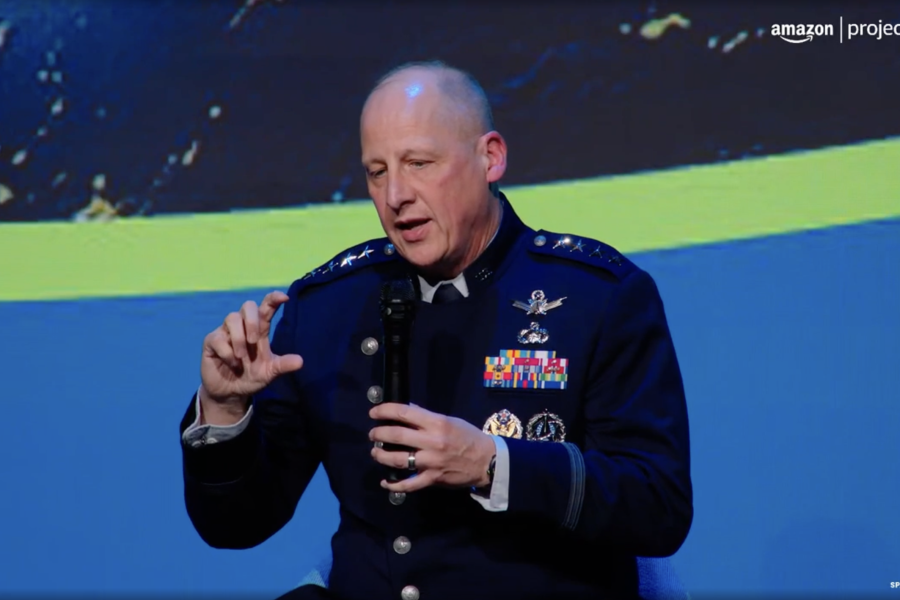Freshly installed as the direct reporting program manager for the Golden Dome missile defense project, Gen. Michael A. Guetlein said July 22 that his first line of effort will be to create a command-and-control network—and argued that the space-based interceptors envisioned for the project are technically difficult but not infeasible.
Guetlein made the comments at a Space Foundation conference just two days into his new job, citing plenty of lessons learned from his time as a Space Force leader as he contemplates how to execute one of the biggest projects in Pentagon history. Golden Dome is meant to be a comprehensive air and missile defense shield for the U.S. homeland.
“I’ve been given 60 days to come up with the objective architecture I need,” Guetlein said in a fireside chat with retired Chief of Space Operations Gen. John W. Raymond. “I owe that back to the deputy secretary of defense in 60 days. So in 60 days I’ll be able to talk in depth about, ‘Hey, this is our vision for what we want to get after for Golden Dome.’”
Guetlein has said he believes the technology that would make Golden Dome possible already exists. “It’s just never been brought to bear on this problem set, to protect the homeland, nor has it been brought to bear on this form factor,” he told Raymond.
The four-star argues Golden Dome will require a level of national effort and coordination on par with the Manhattan Project. Guetlein sees organization as his biggest challenge: how to marshal all the different services, agencies, industry partners, and more needed to make the project work.
To that end, he said Deputy Secretary of Defense Steve Feinberg has granted him sweeping powers to get after the problem, including “budget authorities, acquisition authorities, direct hiring authorities, technical authorities, architectural authorities, liaison authorities.”
Working across bureaucracies and with industry and allies are skills Guetlein has honed through his time as vice chief of space operations and head of Space Systems Command, the Space Force’s acquisition branch, he said.
Command and Control
President Donald Trump has set an ambitious goal for the multibillion-dollar Golden Dome to field a capability by the end of his term in January 2029—a timeline experts argue will be punishing, if not infeasible. To meet that, Guetlein indicated he’ll focus first on connecting existing systems across the armed forces.
“First and foremost is getting out of the gate on C2,” Guetlein said, referring to a command-and-control network that can operate seamlessly across domains and with all revelant systems.
In many ways, the idea is similar to the long-standing Pentagon effort dubbed Joint All-Domain Command and Control, or JADC2, meant to connect sensors and shooters around the globe. The department has claimed a “minimum viable capability” for JADC2, but the sprawling effort has proven challenging and is still ongoing.
For Golden Dome, though, a unified C2 network is a must, Guetlein said.
“We have to deliver on that vision of integrated command and control across the nation, across all these multiple platforms,” he said. “Then we have to bring to bear an integrated network of sensors to be able to close the fire control loop with an integrated network of interceptors that have probably never been brought together before, between the Army, the Navy, the Air Force, and even the Marine Corps.”
Guetlein’s initial plan is to have “incremental demonstrations” of that network every six months, he added, and his work has already begun. He plans to visit U.S. Northern Command and U.S. Space Command in the coming days.
Interceptors
While C2 is the initial priority, the element of Golden Dome that has attracted the most attention is the idea of space-based interceptors, an idea that DOD has bandied about for decades.
SBIs, as they are called, are the biggest technical challenge for Golden Dome, Guetlein acknowledged. But he pushed back against criticism that they are not physically or technically possible.
“I believe we have proven every element of the physics that we can work,” Guetlein said. “What we have not proven is, first, can I do it economically, and then second, can I do it at scale?”
Industry is eager to prove it can. On July 22, Northrop Grumman Chief Executive Officer Kathy Warden disclosed in an earnings call that the company has already started ground testing on an interceptor.
Maj. Gen. Stephen Purdy, acting assistant secretary of the Air Force for space acquisition, told lawmakers during a congressional hearing July 22 that in talking with Guetlein, DOD plans to try “novel ideas like prize activities [and] cooperative work with industry” to get interceptors, instead of developing detailed requirements.
The Space Force has already announced it is conducting market research on interceptors, and Guetlein touted the value of so-called “reverse industry days” for solving hard problems.
“We spend half a day telling you what my problem is, and spend the next day and a half on one-on-ones, listening to you tell me how you think you can solve the problem,” he said.


